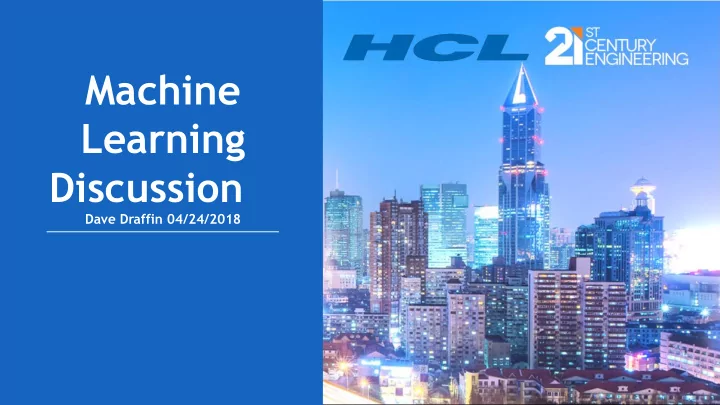

Machine Learning Discussion Dave Draffin 04/24/ 2 018
After this discussion you should: • Know why Machine Learning is needed • Understand the definition of Machine Learning • Understand the types of problems that benefit from Machine Learning • Be aware of some typical uses Goals • Understand the concept of teaching Machines to Learn • Be capable of further study on your own This discussion will NOT teach you how to implement Machine Learning
The Key to Understanding Machine Learning www.hcltech.com
Hand Drop What Happens when I drop the tennis ball by hand – about 4 feet? - ? Rise ? - ? Go sideways? - ? Fall ? How do you know? - Experience - Observation - Equations www.hcltech.com
Hand Drop - Observations Observations - Behaves the same each time (pretty much) - Observed results match equation predictions (Prettyclose) Conclusions - Equations MODEL behavior very well - Equations can be used to PREDICT behavior - ➔ CLOSED FORM Solution www.hcltech.com
Balloon Drop Thought Experiment What Happens when I drop the tennis ball from a balloon 1,000ft up? - No wind What do you observe? - Where does the ball land? - Do the hand drop equations still work? www.hcltech.com
Balloon Drop Thought Experiment - Results What Happens when I drop the tennis ball from a balloon 1,000ft up? - Ball lands directly below the balloon Observations - The ball lands later than prior equations predict. - The ball is moving slower than prior equations predict What is happening? www.hcltech.com
Balloon Drop Thought Experiment - Conclusions What happened? - Air resistance became SIGNIFICANT - It was present in hand drop, but small effect. - With longer drop it became a SIGNIFICANT factor. Can we write equations for this case? - Yes! - A little more complicated - Can still create a CLOSED FORM solution - Actual results will closely match PREDICTIONs www.hcltech.com
Tennis Cannon Shot Thought Experiment Point a perfect cannon at Anaheim Stadium near Los Angeles. - No wind - About 1200 miles What do you observe? - Where does the ball land? - Can we write equations to predict the landing spot? - Why would this be so difficult? Does allowing the existence of wind change your answers? - If you shot it over and over again would the ball land in the same spot? www.hcltech.com
Tennis Cannon Shot Thought Experiment - Conclusions No wind - Ball would land about 1,000 miles off the coast of California (Coriolis effect) - Air density and therefore air resistance would change with temperature. - Is gravity constant? Wind - Winds may not be known at launch - Winds may vary after launch Conclusion - COMPLEX PROBLEM (a lot of elements interacting with each other) - Unknown initial conditions - Unknown change in conditions - Can not create a equation that consistently calculates landing location. - ➔ as the problem gets bigger, longer, further – more factors SIGNIFICANT www.hcltech.com
Tennis Cannon Shot Thought Experiment – Coriolis Effect http://abyss.uoregon.edu/~js/glossary/coriolis_effect.html www.hcltech.com
Machine Learning - Uses Problems without a CLOSED FORM solution - Or where the CLOSED FORM solution is unaffordable Problems with lots of elements that interact Problems where you don’t know the way and degree that elements interact Problems where it is not clear which inputs are SIGNIFICANT www.hcltech.com
Machine Learning – What is it? Machine Learning is a STATISTICAL process - Results are probabilities – not assurances Strives to improve performance to a GOAL - The more learning, the better performance to the goal (in general) Uses FEEDBACK(Learning) to improve GOAL seeking performance Machine Learning builds a MODEL to predict outcomesbased on inputs. - This MODEL may be modified by further learning. Two broad categories - Supervised learning - Unsupervised learning www.hcltech.com
Machine Learning – Supervised Learning Card identification Learning - Color of Letter/symbol - Preset possibilities (red/black) - Letter - Present examples (good and bad) - Symbol - Feedback correct answer - Location - Used to improve model www.hcltech.com
Machine Learning – Unsupervised Learning Goal Seeking Learning - Maximize, Minimize, or both - Totally by experience - Some parameter or small set - May involve training data set - Either end state or continuous - Machine/person interactions - Classifications not predefined - Machine/machine interactions GO! Example - Trained by playing People and other programs, or itself - Plays vastly different than human - Google AlphaGO! Beat some of the best players in the world. www.hcltech.com
Machine Learning – Key “take aways ” Machine Learning is a STATISTICAL process Strives to improve performance to a GOAL (or goals) Uses FEEDBACK(Learning) to improve GOAL seeking performance Machine Learning builds a MODEL to predict outcomesbased on inputs. - This MODEL may be modified by further learning. Requires TRAINING or datasets to improve the model. Useful for large and/or complex problems that don’t have an affordable CLOSED FORM solution. Can identify previously unrecognized relationships (see Analytics) www.hcltech.com
Machine Learning – Questions Questions? www.hcltech.com
Recommend
More recommend